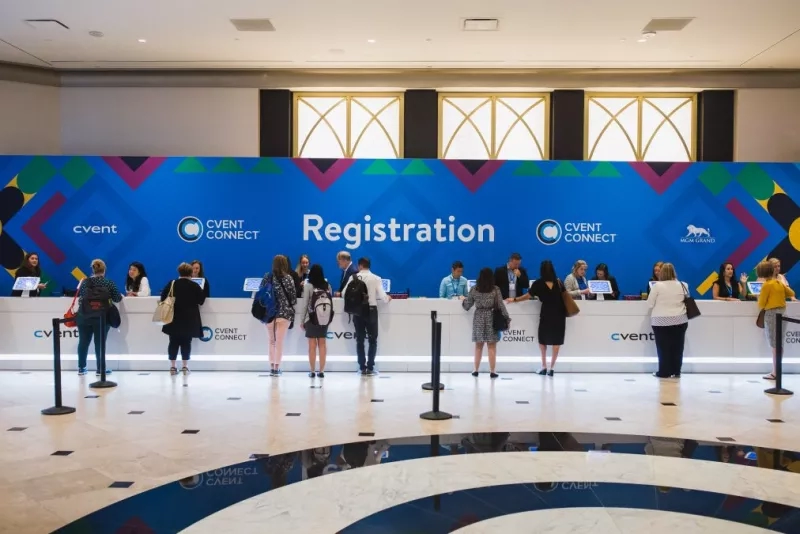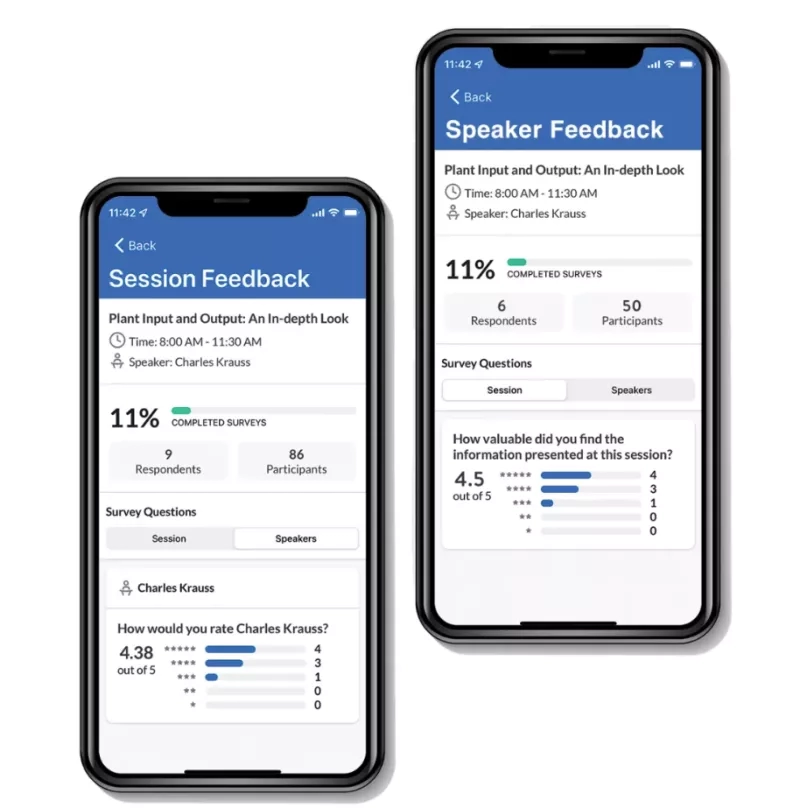Creating a seamless and enjoyable attendee journey is critical to the success of your event. But with so many touchpoints to consider, ensuring a positive and personalised experience for every attendee can be challenging.
Fortunately, technology can help you enhance every step of the attendees’ journey. In fact, with attendees expecting more digital experiences, technology has become a must-have part of your event design.
According to a recent study from Forrester Consulting, on behalf of Cvent, 77% of respondents said that their event attendees have higher expectations for digital features than they did a few years ago.
Read on to learn how you can use event technology to guarantee a great attendee experience, from the moment someone interacts with your brand to long after your event ends.
What is an attendee journey?
Your attendees’ journey refers to all elements of the attendee experience. It’s made up of all the direct and indirect touchpoints they’ll experience from the moment they register or buy a ticket for your event.
It continues with their arrival at the venue, how they engage with your content, and how they engage with other attendees, sponsors and exhibitors. It also includes post-event touchpoints, particularly how they provide you with valuable feedback.
The more you understand your attendees’ journey, the easier it is to identify opportunities to create more personalised experiences that will result in better engagement, higher attendance levels and increased loyalty.
Event technology can support you at every stage so that you can design seamless experiences your attendees will love.
Check out the below video for an example of how technology improved the attendee journey at last year's Cvent CONNECT Europe.
{"preview_thumbnail":"/sites/default/files/styles/video_embed_wysiwyg_preview/public/video_thumbnails/ENqZQ0XOkEw.jpg?itok=AACkPJsI","video_url":"https://youtu.be/ENqZQ0XOkEw?si=svk0DyFOWiVIf9Ey","settings":{"responsive":true,"width":"854","height":"480","autoplay":true},"settings_summary":["Embedded Video (Responsive, autoplaying)."]}
6 Steps to Perfecting the Event Attendee Journey
1. Spark excitement when people register
Give people all the reasons they need to register and start looking forward to your event by creating a great digital first impression.
Make sure your event website has all the latest information, is showing up in Search and is easy to navigate.
Once an attendee has filled out your online registration form, the next step in their journey is to access their print-at-home badge or scanable QR code and to download your event app so that they can start planning their experience.
If your registration site makes these two next steps happen seamlessly, your attendees can plan their meetings and agenda well in advance.
Once you’ve got registrants engaging with the app and plotting their experience, you can send them push notifications with polls, surveys, content or speaker updates while promoting your sponsors and event features.
2. Create a seamless check-in and badging experience
Let's face it: no one wants to spend hours queuing for an event. Your check-in process is an opportunity to ensure that the positive first brand impression you created at registration extends to the physical event itself. In other words, your attendee check-in process should be a seamless experience.
So, how can you help attendees get their badges faster while delivering a seamless experience?
Give your attendees the choice to either scan a personal QR code via your event app to access their badge or to complete a self-check-in process, using screens or tablets available at the check-in desk.
QR codes speed up the badge printing process and free up your check-in staff to help people who need additional help or to register from scratch on arrival.
On-demand badge printing allows you to accept last-minute registrations and walk-ins. Since you no longer have to pre-print and sort through piles of badges, an on-demand badging solution is both a time saver and a more environmentally friendly option that takes into account possible no-shows or name changes.
3. Track sessions for more personalised recommendations
While your event will undoubtedly have lots of enticing content, if you’ve helped attendees download the event app when registering, they will have already created their personalised agendas and be looking forward to attending those sessions that interest them the most.
If you’ve asked them to register for individual sessions via the app, you’ll know in advance which sessions are more popular than others, which will then help shape your future event planning.
When your attendees are on-site, why not send push notifications to promote polls, speaker Q&A and those sessions that haven’t received as much interest?
Using a combination of badge scanning and event app data, you can track what content is proving popular, control room capacities and increase attendee engagement, before and during your event.
Scanning people’s badges as they enter or leave the seminar room provides you with valuable feedback on who attended different sessions. You can then ask for individual feedback while the session content is still fresh in their minds by sending only the scanned badge-holders a request notification to fill out a survey via your mobile event app.
With strategically placed RFID readers, you can also passively scan visitors as they move around the venue. It negates the need to scan every badge on the way into the main keynote session, for example. Plus, it provides a more complete picture of how long people spend in certain areas and what features interest them outside of your education programme.
4. Increase networking opportunities
Networking and making meaningful connections are key reasons people enjoy attending events. So make your event app work harder by including matchmaking appointments and gamification features to encourage networking.
Set up competitions, leaderboards and polls to drive discussions. Ask your attendees trivia questions about the event, or provide fascinating facts that can be used as ice-breakers to initiate conversations.
Additionally, you can use live polls to survey your attendees about various topics, leaving them surprised by the results and sparking thought-provoking conversations. This interactive approach promotes lively debate and encourages attendees to connect.
5. Make event content available on demand
With technology, your event can live on beyond its official end date.
Extend the life of your event and create new opportunities for sponsored revenue and stakeholder engagement by developing a year-round content strategy that will grow an active community and ensure people return to your event time and again.
A content strategy may start with filming specific conference sessions and making them available on-demand via your event platform.
Develop the strategy by working with your marketing team to repurpose and edit the on-demand content for different social channels while creating exclusive new content to entice and excite your audience.
You could film backstage interviews with speakers or provide follow-up learnings on a particular topic. You could create online discussion groups, webinars, key highlights, information about upcoming events and more, all in one place so that attendees will want to keep interacting with your content and sharing it with friends and colleagues long after the curtain’s come down on your event.
Use the engagement data from your on-demand content to plan what attendees find most interesting for future event programmes. Tap into your community of social followers for new content ideas and to keep track of important trends in your sector.
6. Use feedback to understand attendee interests
Technology can not only help you to simplify the process of gathering feedback before, during and after your event, but it can also help you to ask better questions and analyse the results in more depth.
Advancements in survey software allow you to automate survey creation and personalise questions for different audience personas such as sponsors, delegates or exhibitors.
By asking better questions across different audience segments, you’ll get deeper insights that you can compare with previous years and use to predict behaviours and trends, develop content, and gain a deeper understanding of your attendees.
Consider using generative AI tools such as ChatGPT to experiment with different wording and unearth survey questions you may not have thought about asking.
Once you’ve gathered your anonymised attendee feedback, try feeding it into ChatGPT and asking, based on the responses, what improvements you could make to your event. You may be surprised by the results, which could spark an idea you’d never thought of.
Enhance the attendee experience with event tech
By incorporating technology into your attendees' journey throughout the event experience, you will do away with the traditional pain points such as long queues, half-empty auditoria and awkward networking. Plus, you will produce vital data that will allow you to make more informed decisions in real-time and improve your event programmes for years to come.
To learn more about the attendee journey and what engagement strategies to implement at your next event, download our Ultimate Guide to In-Person Events eBook.









